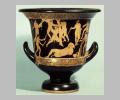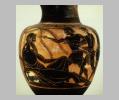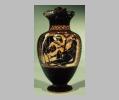|
Odysseus and the Cyclops
Clicking on the thumbnail will open a new browser window.
 |
On his way home from Troy, Odysseus and his companions were blown off course by a storm to the island of the Cyclopes. Intrigued by the sound of sheep and goats, Odysseus and twelve companions decide to explore the cave of Polyphemos, one of the Cyclopes. The Greeks planned to make off with the herd and cheeses in the cave, but before they could get away, Polyphemos returns and blocks the entrance with a huge stone. |
 |
Odysseus expects to be treated as a guest by the Cyclops, but instead Polyphemos devours six of his companions over the next 24 hours. Odysseus comes up with a plan: they will offer the Cyclops wine, get him drunk, and then blind him. When the Cyclops asks Odysseus his name, he answers that his name is Outis "No One." Polyphemos replies that he will reward Outis by eating him last. On this vase, Odysseus' companions are preparing the stake they will use to stab the Cyclops' eye. On the right you can see two satyrs, whose presence indicates the role of wine in making Polyphemus drunk. |
 |
After Polyphemos falls asleep in a drunken stupor, Odysseus and the remaining six companions sharpen a wooden stake in the fire and then drive it into the giant's single eye. The Cyclops runs out of the cave for help and cries out, "Outis ("No One") is killing me by force and treachery!" Upon hearing Polyphemos scream, the other Cyclopes assume that since "No One" is hurting him, it must be an illness sent by Zeus himself. |
 |
The next morning, Polyphemos removes the stone from the entrance to take his flock out to pasture. In order to escape undetected, Odysseus ties each of the other men to the belly of three sheep while he ties himself to the belly of the largest ram. As the herd departs, Polyphemos feels the back of each sheep, but fails to notice the Greeks tied underneath. |
 |
When the Greeks arrive back at the ship, Odysseus boasts that his real name is Odysseus, son of Laertes. Polyphemos breaks off the top of a mountain and hurls it at the ship, just missing. Finally, he prays to his father, Poseidon, to curse Odysseus and keep him from returning home. |
| |
|
To view images of the events after the fall of Troy (including Odysseus), go to A Timeline of the Odyssey (Sutori)
Photo credits:
Drawing of Odysseus offering wine to the Cyclops. Harper's Dictionary of Antiquities (1898).
Red-figure kalyx crater, by the Cyclops Painter. Lucania, 420-10 BCE. British Museum 1947,0714.18.
Attic black-figure oinochoe, attributed to the Theseus Painter. Etruria, 510-490 BCE. Louvre F 342.
Ionian black-figure oinochoe. Rhodes, 500-490 BCE. British Museum 1864,1007.228.
Attic black-figure kylix. 530-20 BCE. Toledo Museum of Art 1927.97.
Attic black figure belly amphora, Würzburg L 248: Side A.
Photograph by Maria Daniels, courtesy of the Martin von Wagner Museum, Würzburg
|




